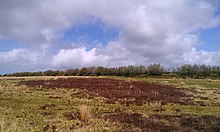 The location of the circle in 2014; the stones are so small that discerning the site is difficult | |
| Location | Porlock |
|---|---|
| Coordinates | 51°11′22″N 3°39′14″W / 51.189549°N 3.653994°W |
| Type | Stone circle |
| History | |
| Periods | Neolithic/Bronze Age |
| Official name | Stone circle, Porlock Common |
| Reference no. | 1006189 |
Porlock Stone Circle is a stone circle located on Exmoor, near the village of Porlock in the south-western English county of Somerset. The Porlock ring is part of a tradition of stone circle construction that spread throughout much of Britain, Ireland, and Brittany during the Late Neolithic and Early Bronze Age, over a period between 3300 and 900 BCE. The purpose of such monuments is unknown, although archaeologists speculate that the stones represented supernatural entities for the circles' builders.
Although Exmoor witnessed the construction of many monuments during the Bronze Age, only two stone circles survive in this area, the other being Withypool Stone Circle. The Porlock circle is about 24 metres (79 feet) in diameter and contains thirteen green micaceous sandstone rocks; there may originally have been more. Directly to the north-east of the circle is a cairn connected to a linear stone row. No evidence has been found that allows for absolute dating of the monument's construction, although archaeologists have suggested that the cairn dates from the Early Bronze Age, the circle being a Middle Bronze Age addition.
A small lead wheel found inside Porlock Stone Circle suggests that the site was visited during the Romano-British period. The site was rediscovered in the 1920s and since then a variety of stones have been added to it; its current appearance is a composite of prehistoric and modern elements. In 1928 the site was surveyed and excavated by the archaeologist Harold St George Gray. A second excavation took place under the leadership of Mark Gillings in 2013.

